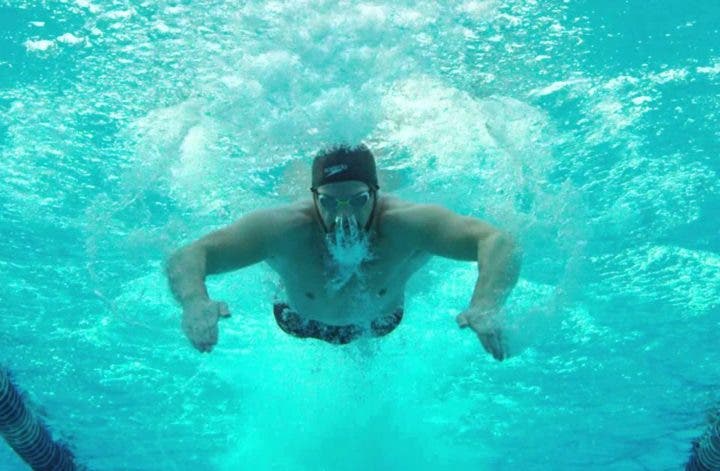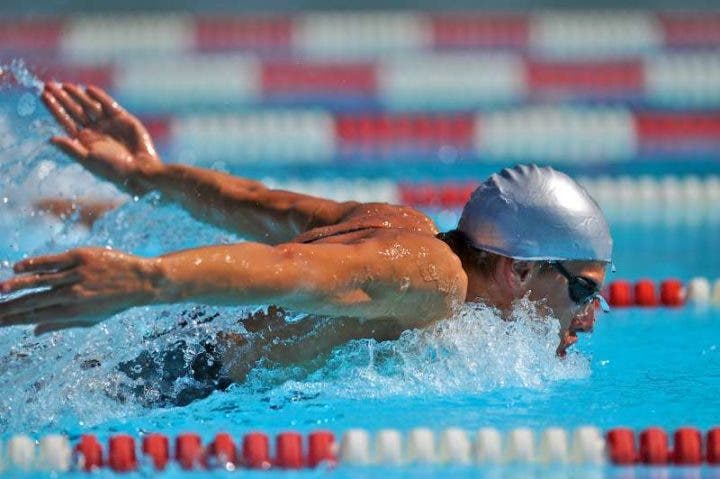Today we address what many consider the most beautiful of styles, the butterfly . In the same way as for the rest of the styles, the butterfly focuses on several basic concepts. First, the position of the body in the water and then the rhythm or coordination of the stroke with the kick.
Unlike the front crawl and backstroke, the butterfly is a style that is developed through a short shaft . A short shaft style is defined as one in which there is intentional rotation of the hip through it. In the case of the butterfly, we can say that it is a style with a high degree of difficulty due to the fact that short muscular efforts must be used for its execution, instead of a continuous effort as is characteristic of long axis styles.
To achieve a better understanding of the movements required to swim the butterfly well, we will divide them into 4 phases:
1. Body position
A correct position of the body in the water is essential for the good execution of all the styles. But in the case of the butterfly it is even more so. Mastering this phase early contributes to a rapid learning of the other elements that make up the style. Since it does not require the body to rotate from side to side through a long axis, the butterfly is more of a style where the swimmer relies heavily on their own perception .
How to do it right?
- Let’s take a pull buoy and place it between our legs.
- Push us off the wall with our arms outstretched in front of us, our gaze directed toward the bottom of the pool.
- Looking for a neutral neck position, the hands should be located slightly more than shoulder width apart, palms facing down, and fingers slightly below the wrists.
- Place your arms in such a way that together with your body they form a Y. This will be the starting position of the stroke and it is the one you should return to at the end of each stroke.
To become more aware of this movement, remove the buoy and feel the movements of your hips and legs. To achieve a balanced position again you must exert a force in a downward direction with your head and chest.
2. The milestone
One of the most common errors we observe during the execution of the butterfly style is an excessive oscillation of the trunk up and down. This happens because swimmers place too much emphasis on the dolphin kick that accompanies the stroke. For more effective learning, we will first focus on the propulsion phase of the stroke .
How to do it right?
- Stand in a horizontal position with respect to the surface of the water, with your arms stretched out in front of you, your hands positioned slightly more than your shoulders apart, with your thumbs pointing towards the bottom of the pool. Your body, hands and arms will form a Y.
- From this point, the hands begin a downward journey to the point that the forearms reach a vertical position.
- Simultaneously the hands begin to move back towards the central body line. This movement propels you forward and gives you lift so you can begin the recovery phase of the stroke.
- Finally, both hands finish their simultaneous trajectory by executing a strong push backwards, placing themselves below the line of the swimsuit just before the arms emerge to start the recovery.
- After this last push, you lift your head to take a breath, keeping your chin as close to the surface as possible.
3. Recovery of the arms
The key to an effective recovery movement lies in avoiding raising your chin too high above the surface of the water.
How to do it right?
- Raise both arms slightly above the surface of the water. When they are aligned horizontally with the shoulders, their entire body will resemble the shape of a T. Don’t try to elevate your torso too much. The key here is being able to execute a smooth and efficient movement.
- Imagine your fingertips gently brushing the surface of the water as you return to the starting position of your stroke, stretched out in front of your head.
- At this point, your legs will be submerged at their lowest point. Here we suggest you relax and allow them to climb. This will occur when your chest leads to change the position of your body in the water.
4. The kick
Possibly the most difficult aspect of the butterfly stroke to master, as it requires a strong midsection (trunk) and good coordination .
In essence, the butterfly requires two strong kicks , one at the beginning of the propulsion phase. The second, right at the end of this phase, providing the swimmer with assistance in terms of propulsion, but more importantly helping him to raise his head above the surface of the water.
The butterfly kick has taken on an important role in swimming in recent years. Nicknamed “ dolphin kick ”, performed correctly it provides the swimmer with plenty of propulsion and a fast underwater movement.
How to do it right?
- Push yourself off the wall, similar to when we were rehearsing the correct body position in the water, except this time the hands are placed one on top of the other, in the arrow position.
- To initiate a movement of a rocking nature, start moving your midsection and hips up and down.
- When the hips and legs rise to the surface of the water, it is time to press them down hard, causing the legs to extend and the feet to point to ballet.
- The kick raises your torso toward the surface, allowing the arms to properly execute the recovery phase of the stroke.
Swimming Butterfly
After doing each of the most important movements that make up the butterfly style separately, it is time to put them all together.
- Pushing yourself off the wall hard, with your arms in arrow position, begin to perform a powerful dolphin kick.
- Just before starting the stroke, when your arms are in the position of maximum extension in front of your head, your hands will be facing outwards, with the thumbs pointing downwards.
- The chest and head will be at their lowest points, relative to the surface of the water.
- Start the stroke with a powerful pull of your hands down and into your body. Hands almost meet below your belly button.
- At this very moment, perform a strong kick to raise your head and torso to the surface of the water.
- Begin the recovery of your arms above the water by moving them forward so that they almost touch the surface. Your hands will be directed backwards with the thumbs directed downwards.
- Finally, return the arms to the position of maximum extension, accompanying them with a second powerful propulsive kick.
Conclusions
The butterfly stroke is one of the most admired by the public and by most swimmers. It is also the most physically demanding. Mastering this style will add a lot of versatility to your workouts , achieving better physical conditioning. By getting it right you can finally say that you are a complete swimmer .
Do you want to learn to swim with different styles?
- How to swim backstroke?
References
- Shawn Gerber. Swim Basics: A Beginner’s Guide to the Butterfly. For Breaking Muscle [Revised October 2015]
- Robert Boder. A brief and basic competitive swimming stroke clinic hondout. For Limmat Sharks [Revised October 2015]
- Gary Hall, Sr. Is Butterfly Swimming a Short Axis Stroke? For The Race Club [Revised October 2015]



